C&C Isle of Skye
Story by Penny Caldwell
Photos by Bill Petro
Ten years late, C&C’s custom power yacht starts to feel like a new idea.
Desolate would be too friendly to describe the bleak grey sky sending sheets of wet snow, the kind of fuzzy rain that sticks to your coat until it’s soaked its way through; the rain-soaked docks that feel slightly slushy underfoot and the five or six boats still in the water, huddled beneath dirty tarpaulins (tarpaulins are always dirty).
Mexican coffee (“a friend brought it back”) and Kaluha followed the blast of warm humid air as Rae Thurston ushers me into the pilothouse. It’s big, warm, dry. Simple and cozy. For a month, Thurston has been calling it home.
Some boats collect owners the way some houses do. They’re bought, character etched subtly with new scratches and paint, and then the owner moves along. Another name on the registry.
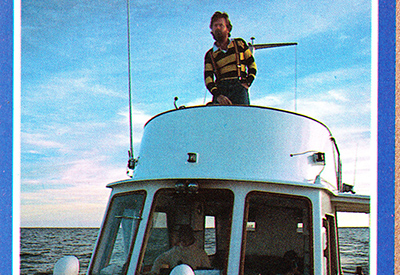 Thurston is the most recent name on Isle of Skye’ s registry. For both, the interaction will probably be just a stop along the way. For Thurston, the boat is convenient while he waits for the perfect Cheoy Lee ketch to come along. But it’s tangible evidence that his dream is meeting reality, and he’s proud of the elegant powerboat that was designed as mother ship to the 1972 Canada’s Cup yachts, associated spectators and, when owner Gordon Fisher had a chance, the Soling fleets in which he raced at Royal Canadian Yacht Club.
Thurston is the most recent name on Isle of Skye’ s registry. For both, the interaction will probably be just a stop along the way. For Thurston, the boat is convenient while he waits for the perfect Cheoy Lee ketch to come along. But it’s tangible evidence that his dream is meeting reality, and he’s proud of the elegant powerboat that was designed as mother ship to the 1972 Canada’s Cup yachts, associated spectators and, when owner Gordon Fisher had a chance, the Soling fleets in which he raced at Royal Canadian Yacht Club.
Three years ago, Thurston dropped out of the high pressure life he was leading as a busy Toronto executive, father of two with a house in Forest Hill. The break with the camera and lighting equipment company where he had worked was amicable and lucrative.
At 35, Thurston considers himself retired, though he works as production manager for a Toronto company making television commercials and, with shrewd investment, says his income is greater than during his formal business career.
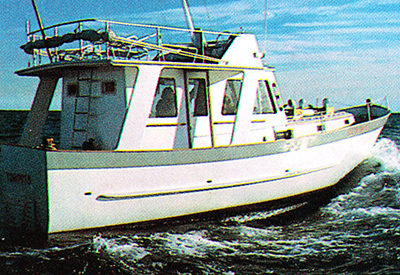 Plan A was to get the boat and go – as far away as possible. “I’ve been figuring out what I wanted for four or five years. I knew I wanted a boat, but I didn’t want to suffer for the next few years from two-footitis.” He decided that to afford the boat he wanted he’d have to live aboard. That meant having more space than he could afford in a sailboat, and he started looking at powerboats. Thurston saw the boat for the first time in August 1980 and moved in two months later.
Plan A was to get the boat and go – as far away as possible. “I’ve been figuring out what I wanted for four or five years. I knew I wanted a boat, but I didn’t want to suffer for the next few years from two-footitis.” He decided that to afford the boat he wanted he’d have to live aboard. That meant having more space than he could afford in a sailboat, and he started looking at powerboats. Thurston saw the boat for the first time in August 1980 and moved in two months later.
”I’d learned enough to recognize this as a different boat as soon as I saw it,” he says. “The more I get into it, I recognize it as a properly-designed boat. ”
Isle of Skye was built in 1971 on a hull brought to the C&C custom division from Mahone Bay, Nova Scotia. Fisher had been impressed with the displacement hull type when he chartered Roving Kind, a powerboat with the same hull, in the Virgin Islands. It was an easily driven boat, sea kindly and capable of cruising. The hull shape was more typical of east coast lobster boats than a Canada’s Cup tender, but it was exactly what he wanted.
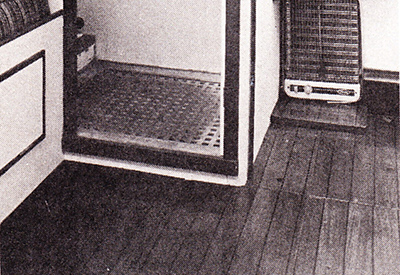 Fisher bought the hull and took it to the C&C custom division in Oakville. C&C’s design team, led by the late George Cassian, took up the challenge. (Cassian and George Cuthbertson, before the days of C&C, had designed Elsie D, Royal Canadian Yacht Club’s committee boat and one of the few powerboats the designers produced apart from market research tests.) The result was Isle of Skye, a powerboat as unusual in its concept and lines now as it was in 1971, particularly on Lake Ontario.
Fisher bought the hull and took it to the C&C custom division in Oakville. C&C’s design team, led by the late George Cassian, took up the challenge. (Cassian and George Cuthbertson, before the days of C&C, had designed Elsie D, Royal Canadian Yacht Club’s committee boat and one of the few powerboats the designers produced apart from market research tests.) The result was Isle of Skye, a powerboat as unusual in its concept and lines now as it was in 1971, particularly on Lake Ontario.
Fisher wanted a boat with a larger-than-normal deck house consistent with his plans for family cruising in Georgian Bay and the Thousand Islands and to use the boat for Canada’s Cup spectators. Having the house further back improved the anchoring characteristics, encouraging the boat to sit with the bow straight into the wind and reduce swinging. He also wanted space to stow his Laser aboard.
The trawler-type hull was easily driven, helped by Wagner hydraulic gearing, and though not a planing design maintained a cruising speed of about 10 knots at half power. The turbo-charged single Perkins six-cylinder diesel engine had adequate power for towing the racing yachts or fleets of Solings.
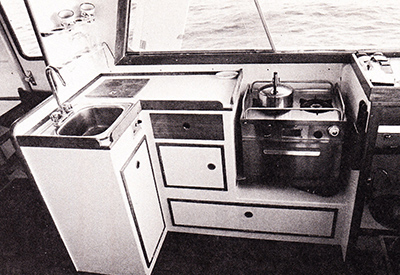 But it’s the style of Isle of Skye that endures through a string of owners. The canted sheer forward, curved topsides to round bilge, raised foredeck and dorade vents combine elements of the typical sailing yacht with her basic power design concept. Thirty-seven feet long, the trim fibreglass hull is only 11 feet one-inch-wide, cutting down on expected accommodations.
But it’s the style of Isle of Skye that endures through a string of owners. The canted sheer forward, curved topsides to round bilge, raised foredeck and dorade vents combine elements of the typical sailing yacht with her basic power design concept. Thirty-seven feet long, the trim fibreglass hull is only 11 feet one-inch-wide, cutting down on expected accommodations.
Teak rails and grab rails on deck would be at home on one of C&C’s cruising sailboats, as would the varnished mahogany sole forward and the interior teak trim.
By most modern power cruiser standards, the interior is simply, if not sparsely, finished. The floor is bare. A port and starboard V berth occupies the enclosed forward cabin while the main cabin adds single bunks port and starboard. The cabin heaters and Shipmate two-burner stove and oven are propane fueled with two 20-pound cylinders. Apart from rewiring the boat, Thurston’s only other immediate plan is to install an Espar heater.
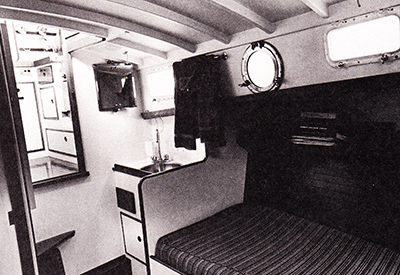 The refrigerator is powered by a Marvel electric compressor and motor inside the engine room. A 30-gallon-capacity fresh-water tank forward is supplemented by a Raritan eight-gallon hot water heater tank. The hot water tank, fresh water tank and a deck wash line and sanitary pump out aft are operated by electric pressure pumps.
The refrigerator is powered by a Marvel electric compressor and motor inside the engine room. A 30-gallon-capacity fresh-water tank forward is supplemented by a Raritan eight-gallon hot water heater tank. The hot water tank, fresh water tank and a deck wash line and sanitary pump out aft are operated by electric pressure pumps.
“When Gordon Fisher builds a boat he has his own ideas, which in my opinion always work out very well,” says Erich Bruckmann, vice-president of C&C Yachts and manager of the custom shop in Oakville. “The boat was built for a sailor, designed by a sailor and has features you would not usually find on power boats. You can’t compare it with conventional powerboats because it’s a character boat built by a man who knew exactly what he wanted.”
For Thurston, Isle of Skye wasn’t exactly what he had in mind; he came upon the boat more by chance than pursuit. But it’s not altogether surprising that this carefully designed, specifically built boat should surface in the care of a relatively inexperienced boater who describes his new life as “definitely organized to be loose.”
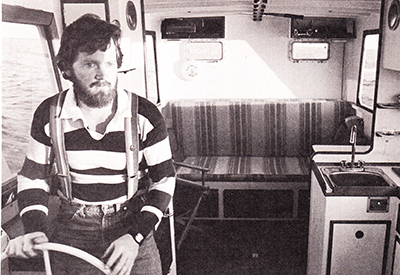 Isle of Skye suits his sense of individuality that wouldn’t be satisfied by a production boat – “everybody has one of those.” Top of the line, a forerunner of the fashionable trend in trawler-type yachts, seaworthy and, as one surveyor understated, “more heavily constructed than is usual for a fibreglass cruiser,” Thurston likes to be able to turn the key and go. Not complicated to maintain and repair, the boat is compatible with the technical knowledge he has developed through his work.
Isle of Skye suits his sense of individuality that wouldn’t be satisfied by a production boat – “everybody has one of those.” Top of the line, a forerunner of the fashionable trend in trawler-type yachts, seaworthy and, as one surveyor understated, “more heavily constructed than is usual for a fibreglass cruiser,” Thurston likes to be able to turn the key and go. Not complicated to maintain and repair, the boat is compatible with the technical knowledge he has developed through his work.
Best of all, Isle of Skye is his. “It’s nice to be part of this boat. It’s got history, and it’s not an atrocious history. Just being one of the names on the registry list would be fun,” he says.
Thurston admits his interest in the boat may be another flash in the pan, a concession to self-styled spontaneity that will move into the background with scuba diving, photography and airplanes. If the right sailing cruiser comes along, he’ll buy it, turn Isle of Skye over to the next proud owner and sail south. If it doesn’t, well, he predicts he’ll be happy on the boat for a long time.
Originally published in Canadian Yachting’s February 1981 issue.
Specifications:
Length – 37 ft
Water Capacity – 30 gal
Hot Water Heater Tank – 8 gal
 Photo Captions:
Photo Captions:
Photo 1 – the C&C Isle of Skye
Photo 2 – Built on a Nova Scotian lobster boat hull, Isle of Skye was designed by the late George Cassian.
Photo 3 – A larger house was consistent with the first owner’s plans for cruising; the deck was long enough for his laser.
Photo 4 – The spare elegance of Skye’s interior predates the current fad for oiled teak.
Photo 5 – Galley
Photo 6 – Main Cabin
Photo 7 – With a narrow 11-foot beam, Skye has less interior space than a more conventional powerboat. Its layout borrows from sailboat convention with single settee on both sides of the main cabin. The single engine is a turbocharged Perkins six diesel with adequate power for towing racing yachts, its original purpose
Photo 8 – Helm






















